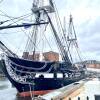Advisory: This story includes descriptions of abuse and oppression of Black people, which were the norm in colonial-era Boston.
The Old Corner Bookstore, a former apothecary shop that is now home to a fast-food restaurant, is a bit of an afterthought on the Freedom Trail.
Built in 1718 by a mostly forgotten Boston resident named Thomas Crease, it has very little to do with freedom or revolutionary history.
But even this building, touted as the city's oldest commercial building, has connections to slavery.
In 1727, Crease sold the land beside it to Andrew Cunningham, who built a home his family occupied for decades. City records show the Cunninghams enslaved people. The current Old Corner Bookstore site includes both addresses.
And while there is no record of Crease owning or employing enslaved people, it appears to have been common practice in businesses such as his.
Studies of the legal treatment of enslaved people often highlight the 1755 case of Mark and Phillis, who were accused of murdering their enslaver, John Codman, with poison. A Massachusetts Historical Society recounting of the case details how they conspired to gather the toxins from other enslaved people working in apothecaries. The report states that “application was made by Mark, first to Kerr, the servant of Dr. John Gibbons, and then to Robin, the servant of Dr. Wm. Clarke, at the North End of Boston, for poison from their masters' apothecary stores.”
Apothecaries were also broadly connected to the slave trade, because boats crossing the Atlantic needed supplies of medicines to battle illnesses contracted in places where enslaved people were captured.
The historic building became a publishing house in the 1820s. From 1833-1865 it was home to publishers Ticknor & Fields, issuing such well-known authors as Ralph Waldo Emerson and Nathaniel Hawthorne. The firm also published later editions of Harriet Beecher Stowe’s anti-slavery classic “Uncle Tom’s Cabin.”
This story is part of the project Enslavement History of the Freedom Trail , a collaborative effort between GBH News and Boston University students to detail the mostly hidden history behind some of Boston's most well-known sites.








